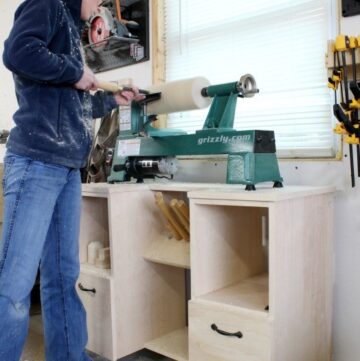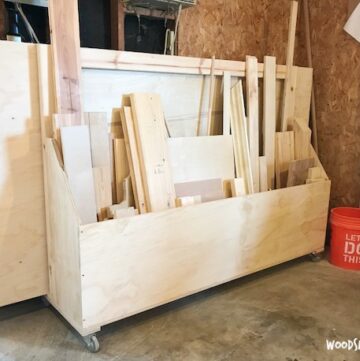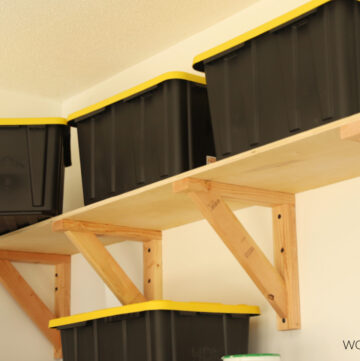Welcome to Workshop 101! This is part 4 of a five part series I’m excited to be sharing! Part 4 will cover working on the go and how to take your workshop off site.
.
This post is sponsored by The Home Depot and contains affiliate links. See policies.
After building my sister’s kitchen cabinets a few weeks ago, my shop was a complete wreck. Nothing was organized, everything was covered in sawdust, and I had misplaced several of my favorite tools while transporting them between her house and my shop. #hotmess

So I decided to get my crap together and get my shop back in shape. And that’s what sparked me to write this series. Each Wednesday for five weeks, I’ll be covering the topics listed below here on the blog, but I’ll also be giving my shop an overhaul behind the scenes so that at the end of the series, I will reveal my own shop before and after.
.
Today is workshop on the go, but we will be covering the following topics in the coming weeks:
- Part 1: Workshop Maintenance
- Part 2: Workshop Organization
- Part 3: Workshop MVPs
- Part 5: My Before and After Workshop Overhaul
.
Let’s get to Part 4–taking your workshop on the go.

If it hasn’t already happened, it will. I think it’s only a matter of time once you start your woodworking and DIY journey that someone—mom, dad, sister, friend, neighbor down the street, stranger you met at the grocery store—asks you to come over and help them with a project. Or, you know…DO the entire project.
.
At some point in your life, there will come a situation in which you will need to load up your tools and take them to an off site job to work. Even if it’s to hang a picture at your best friend’s house. (Or cabinets at your sisters…)

I’m here to help you prepare for when that time comes and give you some tips for taking your workshop on the go.
Tip #1: Make a List and a Plan
I’m a list person. I live and die by my to do list. And I understand some people are not. But I’ve found that if I sit down and make a list of the tasks I need to complete on my off site job, I can easily turn around and list out the tools and materials I will need to complete those tasks, pack everything up, and be on my way.

So even if you’re not a list person, you may (like I do) find it helpful (at least at first) to make a step by step “task list” for whatever you are doing off site, then list out a “tools and materials list” based off your task list.
.
For example, when I installed my sister’s kitchen cabinets, my “task list” looked something like this:
- Level and install corner blind cabinet
- Add 1 ½” trim piece on left side
- Install trash can pull out cabinet next to trim piece
Etc. Etc. Etc.
.
So looking at my list, I saw first I need to level. So I’m going to need shims. Add that to the tools and materials list. Then I’m going to need to install the cabinet. So I’m going to need some screws and a driver with the correct bit to drive the screws. Add those things to the list. Next, I need to make sure I’ve cut the 1 ½” wide trim piece and add that to the list. You see how this goes?

I’ve found this process IMMENSLY helpful as I’ve taken my work on the go so that I don’t have to remember all the things I need off the top of my head. The process, tools, materials, and strategy have already been thoughtfully planned and listed out.
Tip #2: Prepare for the Worst
I know I sound like a Negative Nancy here, but it’s always best to plan and be prepared for the worst when you are taking your work off site so that you make sure you have EVERYTHING you need on hand.
.
So you’ve made your task list from tip #1. Now go back and see what could possibly go wrong.
.
For example, let’s say you built a cabinet for a friend that is supposed to be built into a nook in their living room. Let’s say when you get it installed, you find the walls weren’t square and now you have a ¼” gap on one side of it that you weren’t planning for. Think ahead and anticipate issues like this and how you can fix them…like adding a small piece of trim.

Then make sure you add what you need to the tools and materials list so you will have what you need to not only install the original cabinet, but also the trim piece or whatever else you may have to install.
.
Now, those are my biggest tips for the planning and preparedness part of working on the go. Now let’s talk about the packing part.
Tip #3: Keep Small Parts Organized
If you read part 2 of the series, this may seem familiar. My number 1 tip for keeping your shop organized was to keep small parts organized. But this is even more important when you’re on the go. Transporting lots of tiny parts like drill bits, nails, screws, paint can openers, even pencils and measuring tapes can be a nightmare if all you have to put them in is the floor board of your truck.

I’ve been there more times than I want to admit. Keep your small parts contained while you’re on the go with these interlocking Husky storage containers.

I used these recently when I was installing the cabinets I built for my sisters kitchen and her window trim. They were easy to transport since they lock together and I could carry and keep organized all the nails for my nail gun, paint can openers and brushes for touchups, screws, and sandpaper. No lost drill bits under the truck seat, no spilled screws in the bed of the truck.
Tip #4: Make Tools Easy to Carry
Now that small parts are organized, it’s time to focus on the bigger things…like tools. When you take your tools to an off site location to work, it’s best to make them easy to pack from the truck to the work site.

I used this Husky 19” ProHybrid Tote to carry all my tools when I recently installed my sister’s kitchen cabinets and it was a life saver! One trip from the truck to her garage and I was set up and ready to go. It can carry most of my major tools, plus has little bungees and pockets lining the inside to help contain small parts.

It’s also got a removable zippered pack on the side for storing screw drivers or other small parts, but it’s the perfect size for a laptop, notebook, folders, etc. (Hint hint…you can stick your lists from tip #1 in here 😉 )

But if you’re taking more than this tote can handle, this Husky 22″ Connect Rolling System Tool Box is another great option. It’s got three interlocking sections—one large one on the bottom, a smaller one with removable tray in the middle, and one small parts organizer on the top.

So technically, you can take care of both tips 3 & 4 both with this option. I actually didn’t get this until after I installed my sister’s cabinets, but it would have been ideal for taking with me on that adventure.

I love that this one is on wheels, so you can load it down and not have to worry about it being too heavy to pack around.

Tip #5: Remember to Charge Batteries
My last tip is kind of a no brainer, but is worth repeating. Many times, when you take your work off site, power isn’t readily available OR it’s not ideal to be tripping over extension cords while you’re doing whatever you’re doing.
.
Battery powered tools are ideal for on the go work. BUT, only if you remember to keep your batteries charged. This can be complicated when you have several different brand batteries to keep charged.
.
I’m sure there are much more sophisticated options for this, but here’s what I’ve done. I recently took a scrap piece of plywood and attached all my chargers to it. I used small ⅝” wood screws and screwed them into the board spacing them appropriately so that the chargers will slide on like shown. While I’m in my own shop, I leave this board screwed to the wall and they’re plugged into my Husky Mobile Workbench power strip.

But when I’m ready to pack up and work off site, I can simply unscrew this from the wall, throw it in the truck along with a power strip of my own and once I get on site, I just plug in this one power strip and keep my batteries juiced up. It’s crude and not super fancy by any means, but keeping all my chargers mounted together and just using one outlet, this makes charging one less thing I have to worry about when I’m on the go.

So I hope these tips have been helpful and I hope you guys are enjoying this series. I’m really enjoying sharing it with you and hope by me sharing what little knowledge I have has been a help to you in your workshop life 😊
.
If so, I’d love if you’d share these posts and be sure to pin this for later.

Stay tuned for next week when I show off my own shop and how I transformed it with my own Workshop 101 Series tips and a little sweat and sawdust 🙂 Until next time, happy building!






Wow Sara,
Sure looks like you are getting a work out toting those tools around.
It inspires me to see your work and the time that you have to share your craft!
Organization is important no matter how big or little your work space it, it leads to efficiency and better time management.
Being organized improves accountability, knowing where the little things are (chisels, blades, bits) so you don’t have to waste time running back & forth from the Job site to your Woodshop looking for something that was placed in the wrong place or burried in with other tiny things.
Tool chest, organizers and Tool boxes are a great way to maintain Accountability & Efficiency
Very Professional.
Thank you! Organizing my shop this summer was the best thing I could have spent my time doing. It feels SO much better to have everything in its place!